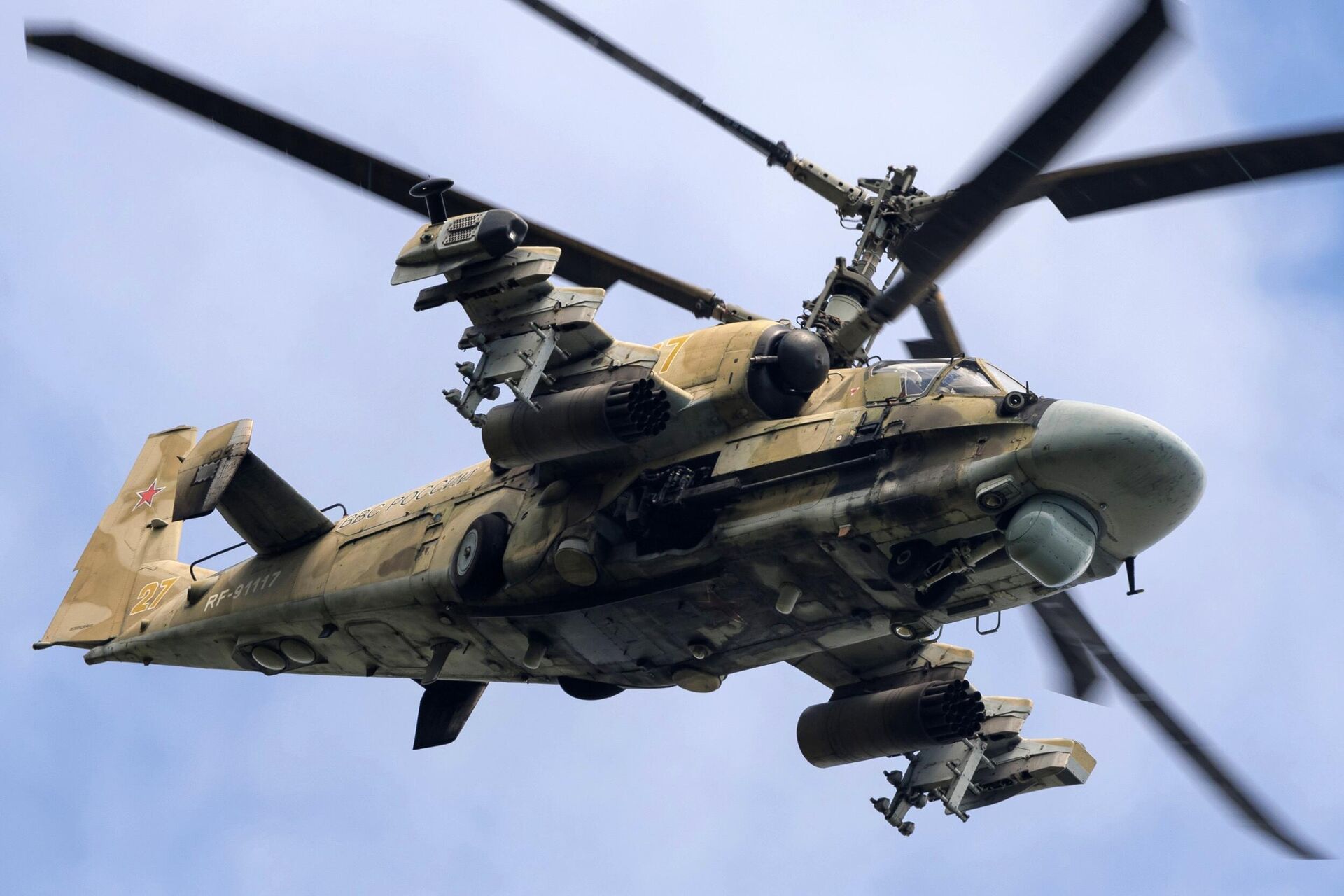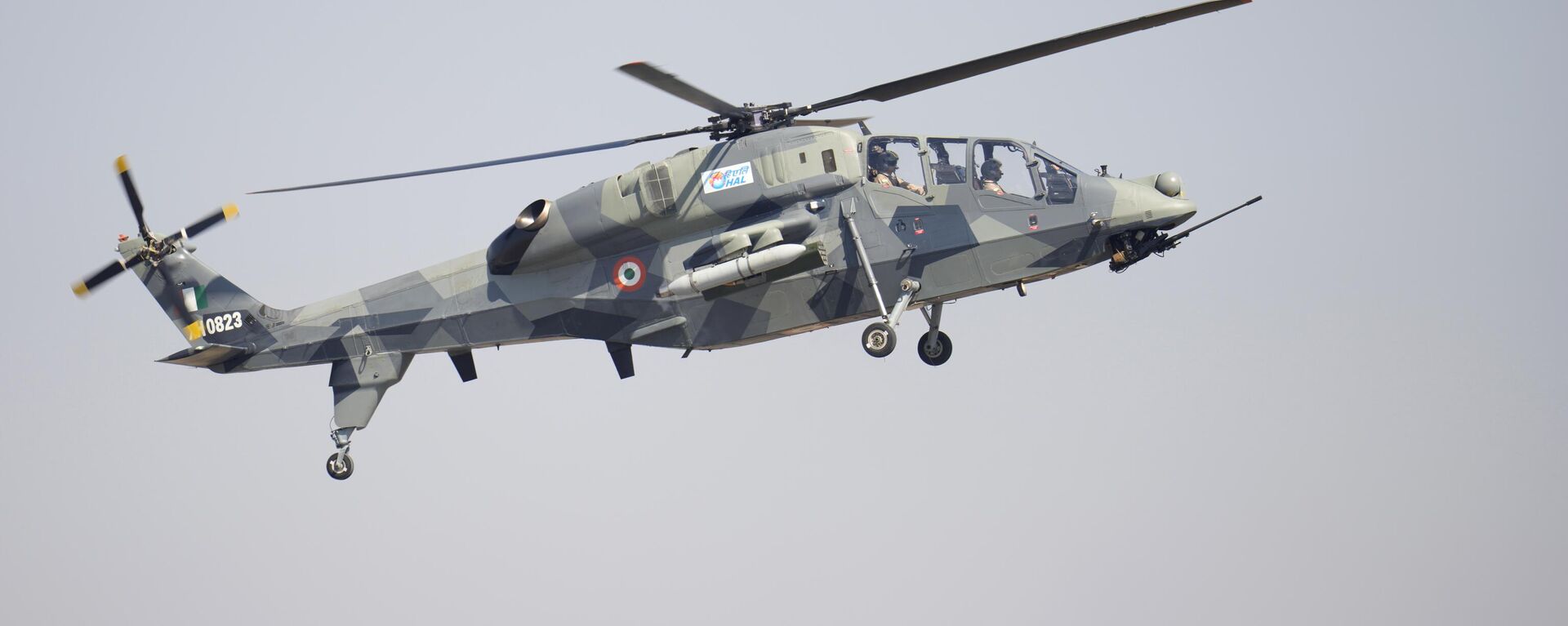Emerging Powerhouse in the Sky: India Surges Ahead With Prachand Helicopter Launch

© AP Photo / Aijaz Rahi
Subscribe
India has been enhancing its military capabilities since rising as a new great power. Military analyst Vijainder K Thakur reveals the capability of Delhi's indigenous Prachand Light Combat Helicopter in his column for Sputnik India.
On November 30, the Defence Acquisition Council (DAC) accorded AoN (Acceptance of Necessity) for the acquisition of 156 Prachand Light Combat Helicopters (LCHs) for use by the Indian Air Force (IAF) and the Indian Army (IA). Such a large order for a helicopter with limited operational service and no combat exposure is unprecedented. (As a comparison, the RuMoD's last order for the combat proven Ka-52M was for 114 helicopters.)
The bold move by the DAC is likely a challenge to state owned HAL (Hindustan Aeronautics Limited), the developer of the helicopter, and the DRDO (Defence Research & Development Organisation), the developer of the helicopter's sensors and weapons fit, to come good with their promise and potential, and truly make the country self reliant in weapon systems development.
In the past, HAL and DRDO have repeatedly alluded that the services and the MoD are often responsible for the delays and failures of locally developed weapon system, because of their reluctance to commit to a weapon system at an early stage of development.
The Imperative for Prachand
It's likely that the role of combat helicopters in the ongoing Russian special military operations (SMO) in Ukraine weighed on the minds of the DAC while clearing such a large acquisition. The ability of the Russian Ka-52M and Mi-28N combat helicopters to strike Ukraine's US/NATO supplied armour from standoff ranges was one of the reasons why the Ukrainian counter offensive in June failed.
The Russian Ka-52M and the US Apache AH-64E are good combat helicopters but the Prachand LCH is the best combat helicopter, as far as India is concerned! Not just because it was developed in India, but because it was honed to address Indian defence requirements.

Comparison of attack helicopters: KA-52 Alligator vs AH-64 Apache
© Sputnik
The big advantage in developing weapon systems indigenously is the freedom to develop a weapon system that precisely meets qualitative requirements (QRs) specific to the threats faced by the nation. When you procure weapon systems from other countries, you need to adapt them to your nation's specific needs, which very often results in degradation of the weapon systems' capabilities.
Prachand was developed to QR's (Qualitative Requirements) that fit India's operational requirements like a glove. India's disputed borders run through mountainous terrain. The IA and the IAF need a combat helicopter that can fly at high altitudes with adequate sensors and weapons load, while retaining the agility to manoeuvre in tight airspaces between mountains with ease that allows the pilots to find and engage targets.
Tough requirements, all of which the Prachand meets!
The Promise of Prachand
The Prachand is a 5.8-ton, Low Observable (LO) design with reduced visual, aural, radar, and infrared (IR) signatures. It features canted panels for lower radar cross section and an IR suppressor for low IR signature.
The helicopter has a maximum speed of 275 kmph (148kt), a combat radius of 500 km and is capable of high-altitude warfare with an operational ceiling of 16,000 to 18,000 feet.
Prachand's stub wings/armament booms have four weapon attachment stations, two on each side. Each station can carry ATGMs or rockets; or air-to-air Missiles.
The helicopter has fixed armour plating on the sides and crash-worthy landing gear for better survivability.

India's indigenous light combat helicopter Prachand flies over a bird during the inauguration of the Aero India 2023 at Yelahanka air base in Bengaluru, India, Monday, Feb. 13, 2023.
© AP Photo / Aijaz Rahi
The Gap Between Promise & Lethality
The promise of Prachand needs to be realised as lethality in combat, something that can only happen if it gets the sensors and weapons required to leverage its outstanding aerodynamic capabilities.
For the DAC's gambit to clear purchase of a large number of Prachand LCHs to succeed, the lessons of the success of Ka-52M in Ukraine must be clearly understood.
The Ka-52M has proven to be very lethal during the SMO because it
1.
Can engage targets at stand off ranges with Vikhr-1 (10-km range) and Product 305 (14.5-km range) precision guided missiles. Using long range precision guided missiles, the helicopter can operate safely out of range of Ukrainian MANPADS.2.
Features sensors that support long range missiles. The GOES-451 multi-channel optical sighting system and an onboard AESA radar facilitate identifying and engaging targets at long ranges.3.
Features a high bandwidth communication suite that facilitates exchange of target imagery and data.4.
Can safely operate along the battlefront under Russian Aerospace Forces (RuAF) air cover.In the subsequent paragraphs, we will take a closer look at what the Prachand already has and what it could get in the future.

Combat helicopter Ka-52 at the 'Vostok 2022' military maneuvers at the Sergeevsky training ground.
© The Russian Defense Ministry
/ Stand Off Missiles
Currently, the Prachand is proposed to be equipped with the Helina ATGM,
Helina
The Helina missile can engage targets between 500 m to 7 km range.
It features a 640x512px FPA (Focal Point Array) IIR (Imaging IR) seeker. In simple terms, that means the Helina seeker can image the target, not just detect it, giving the missile the ability to recognize a target and ignore other heat sources in the vicinity of the target!
The Helina always uses LOBL (Lock on Before Launch) tracking making it a “fire and forget” missile. Once the Electro-Optic (EO) system of ALH identifies the target, it automatically hands over the target to the missile.

Flight test of indigenously developed helicopter launched Anti-Tank Guided Missile ‘HELINA’ carried out from Advanced Light Helicopter
© Photo : DRDO
SANT ATGM
The DRDO is in the process of developing the SANT missile that can neutralise targets at a range up to 10 kms. The missile reportedly features an advanced millimetre wave (MMW) seeker.
According to a MoD press release, "SANT is a smart Stand-off Anti-Tank Missile being developed for launch from a Mi-35 Helicopter for Air Force anti tank operations."
From the wording of the press release, it's evident that the SANT missile cannot be used with the Prachand LCH, at least for now. Either because the Prachand lacks a sensor to locate and engage a target at 10 km range, or because the missile is too heavy for carriage by Prachand.
The SANT missile has been designed and developed by Research Centre Imarat (RCI), Hyderabad in coordination with other DRDO labs and participation from industries.
Prachand Sensors
The Prachand is equipped with an Electro-Optical Pod consisting of a CCD camera, FLIR, Laser Range Finder (LRF), and Laser Designator (LD), giving the attack helicopter the ability to detect and acquire targets day or night.
It's not known if an AESA radar is proposed to be developed for the LCH. Weight constraints might rule out the option, in which case the Prachand's ability to carry long range missiles may be severely constrained.
Prachand Communication Suite
Not much information is in the public domain about Prachand's communication suite. A modern combat helicopter needs high bandwidth communication with support for direct communication with UAVs.
The modernised Ka-52M, for example, automatically receives data from the Sagittarius reconnaissance, command and communications complex, which provides real-time information about the combat situation on the ground and likely targets.
It's unlikely that the Prachand currently has a high bandwidth communication suite adapted to work within a battlefield command and control system. If the assessment is correct, an improved communication suite must be a priority item on HAL's Prachand to-do list.
Battlefront Air Dominance
The success or otherwise of the Prachand LCH in any future confrontation will depend, to a very large extent, on the IAF's ability to establish air dominance along the battlefront in support of Prachand operations.
Operating against the PLA, the IAF could leverage the higher endurance and payload of its Su-30 MKI fighters, which would be operating from air bases at near sea level, as compared with PLAAF fighters operating from high altitude air bases. However, the limited number of AWACS assets and the complete absence of a long range air-to-air missile like the RVV-BD in its inventory will severely limit the effectiveness of the air dominance support that the IAF provides.
However, it's likely that the IAF will address these shortcomings in the future.
Conclusion
The Prachand LCH still needs a lot of development effort for it to become a formidable operational asset.
India needs combat helicopters in much larger numbers than the 156 deemed necessary by the DAC at this point of time. It's almost certain that if HAL and the DRDO deliver on the promise of the Prachand, there will be more orders for more advanced variants of the helicopter in the future.
What must not happen is that HAL delivers 156 Prachands without the sensors, weapons and communication suite required for Army and Air force pilots to operate safely and effectively along the battlefront. By doing so, HAL will be doing a great disservice to the nation and the aspirations of its citizens
As things stand, the PLA is unlikely to be worried about the large number of LCH proposed to be built by HAL. However, if the helicopter is equipped and armed as discussed above, the PLA will have a lot to worry about.
One big challenge before the DRDO and HAL would be to add capability to Prachand without increasing its weight. A weight spiral will eliminate the raison d'etre for the Prachand.

